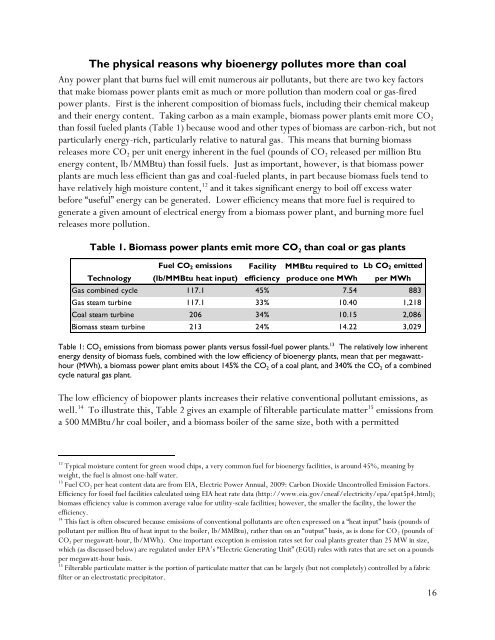PFPI-BiomassIsTheNewCoal-April-2-2014
PFPI-BiomassIsTheNewCoal-April-2-2014
PFPI-BiomassIsTheNewCoal-April-2-2014
- No tags were found...
You also want an ePaper? Increase the reach of your titles
YUMPU automatically turns print PDFs into web optimized ePapers that Google loves.
The physical reasons why bioenergy pollutes more than coalAny power plant that burns fuel will emit numerous air pollutants, but there are two key factorsthat make biomass power plants emit as much or more pollution than modern coal or gas-firedpower plants. First is the inherent composition of biomass fuels, including their chemical makeupand their energy content. Taking carbon as a main example, biomass power plants emit more CO 2than fossil fueled plants (Table 1) because wood and other types of biomass are carbon-rich, but notparticularly energy-rich, particularly relative to natural gas. This means that burning biomassreleases more CO 2 per unit energy inherent in the fuel (pounds of CO 2 released per million Btuenergy content, lb/MMBtu) than fossil fuels. Just as important, however, is that biomass powerplants are much less efficient than gas and coal-fueled plants, in part because biomass fuels tend tohave relatively high moisture content, 12 and it takes significant energy to boil off excess waterbefore “useful” energy can be generated. Lower efficiency means that more fuel is required togenerate a given amount of electrical energy from a biomass power plant, and burning more fuelreleases more pollution.Table 1. Biomass power plants emit more CO 2 than coal or gas plantsTechnologyFuel CO 2 emissions(lb/MMBtu heat input)FacilityefficiencyMMBtu required toproduce one MWhLb CO 2 emittedper MWhGas combined cycle 117.1 45% 7.54 883Gas steam turbine 117.1 33% 10.40 1,218Coal steam turbine 206 34% 10.15 2,086Biomass steam turbine 213 24% 14.22 3,029Table 1: CO 2 emissions from biomass power plants versus fossil-fuel power plants. 13 The relatively low inherentenergy density of biomass fuels, combined with the low efficiency of bioenergy plants, mean that per megawatthour(MWh), a biomass power plant emits about 145% the CO 2 of a coal plant, and 340% the CO 2 of a combinedcycle natural gas plant.The low efficiency of biopower plants increases their relative conventional pollutant emissions, aswell. 14 To illustrate this, Table 2 gives an example of filterable particulate matter 15 emissions froma 500 MMBtu/hr coal boiler, and a biomass boiler of the same size, both with a permitted12 Typical moisture content for green wood chips, a very common fuel for bioenergy facilities, is around 45%, meaning byweight, the fuel is almost one-half water.13Fuel CO 2 per heat content data are from EIA, Electric Power Annual, 2009: Carbon Dioxide Uncontrolled Emission Factors.Efficiency for fossil fuel facilities calculated using EIA heat rate data (http://www.eia.gov/cneaf/electricity/epa/epat5p4.html);biomass efficiency value is common average value for utility-scale facilities; however, the smaller the facility, the lower theefficiency.14This fact is often obscured because emissions of conventional pollutants are often expressed on a “heat input” basis (pounds ofpollutant per million Btu of heat input to the boiler, lb/MMBtu), rather than on an “output” basis, as is done for CO 2 (pounds ofCO 2 per megawatt-hour, lb/MWh). One important exception is emission rates set for coal plants greater than 25 MW in size,which (as discussed below) are regulated under EPA’s “Electric Generating Unit” (EGU) rules with rates that are set on a poundsper megawatt-hour basis.15Filterable particulate matter is the portion of particulate matter that can be largely (but not completely) controlled by a fabricfilter or an electrostatic precipitator.16



